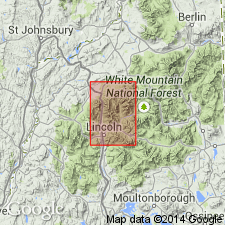
- Usage in publication:
-
- Kinsman quartz monzonite
- Modifications:
-
- Principal reference
- Dominant lithology:
-
- Quartz monzonite
- AAPG geologic province:
-
- New England province
Summary:
Pg. 9, 20, map; see also M.P. Billings, Geol. Littleton and Moosilauke quadrangles, NH, 1935. Kinsman quartz monzonite. Occupies much of western and northern parts of Franconia quadrangle and extends north into Rumney and Plymouth quadrangles, Ammonoosuc River region, northwestern New Hampshire. Is white to gray, coarse- to medium-grained; in places contains large white crystals of potash feldspar 1 to 2 inches long. Is younger than Littleton formation and either late Devonian or late Carboniferous. Assigned to New Hampshire magma series.
Named from Kinsman Notch, [5 mi west of North Woodstock, Mount Moosilauke 7.5-min quadrangle, Grafton Co., White Mountain National Forest], northwestern NH.
["New Hampshire magma series" considered informal. The practice of employing "Series" for lithostratigraphic or lithodemic nomenclature is now regarded as improper. Term "Series" is applied formally only to chronostratigraphic units (ACSN, 1961, 1970; NACSN, 1983, 2005, 2021).]
Source: US geologic names lexicon (USGS Bull. 896, p. 1102).
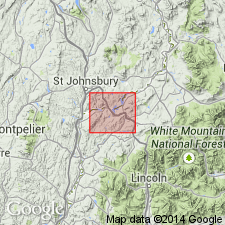
- Usage in publication:
-
- Kinsman quartz monzonite
- Modifications:
-
- Mapped
- AAPG geologic province:
-
- New England province
Summary:
Pg. 506-507, pl. 12 (geol. map). Kinsman quartz monzonite. White to gray, medium-grained, and locally porphyritic or gneissic. White, tabular phenocrysts of potash feldspar, showing Carlsbad twins, are conspicuous in places. Groundmass composed of feldspar, quartz, biotite, and muscovite. Similar rocks have been called Meredith granite elsewhere in New Hampshire. Intrudes Early Devonian rocks; sill-like rocks cut Littleton formation.
Notable exposures along eastern edge of Moosilauke quadrangle, Grafton Co., northwestern NH (Kinsman Notch area).
Source: Publication; US geologic names lexicon (USGS Bull. 1200, p. 2025-2026).
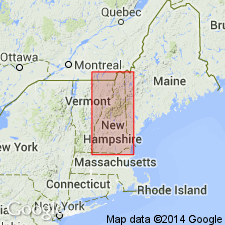
- Usage in publication:
-
- Kinsman quartz monzonite
- Modifications:
-
- Revised
- Areal extent
- AAPG geologic province:
-
- New England province
Summary:
Includes Meredith granite of Lake Winnipesaukee region, NH, as well as the "Franconia" breccia. The nine principal bodies or areas are 1) a body in the extreme southwest corner of the state that is 12 mi long, 6 mi wide; 2) the Cardigan pluton (the largest Kinsman body) that is 60 mi long and up to 12 mi wide; 3) a group of four small bodies lying between Dublin and the NH-MA border; 4) the Rumney pluton, which stretches from north of Rumney to 4 mi east of Woodstock; 5) the Lincoln pluton, which extends 5 mi southwest of Woodstock to 2 mi south of Twin Mountains village; 6) the Winnipesaukee pluton, which consists of the Meredith phase of the Kinsman and the Winnipesaukee quartz monzonite; in addition, many smaller bodies are located near Lake Winnipesaukee, Squam Lake, and village of Alton Bay; 7) an irregular body 6 mi long east of village of Waterville Valley; 8) a body 5 mi long southeast of Mount Carrigain summit; and 9) a body 4 mi long located 5 mi west of North Chatham.
Source: GNU records (USGS DDS-6; Reston GNULEX).
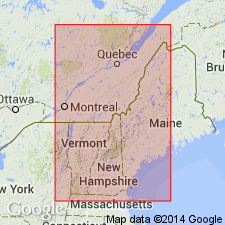
- Usage in publication:
-
- Kinsman Quartz Monzonite*
- Modifications:
-
- Age modified
- AAPG geologic province:
-
- New England province
Summary:
Age of Bethlehem Gneiss and Kinsman Quartz Monzonite changed to Early(?) Devonian.
Source: GNU records (USGS DDS-6; Reston GNULEX).
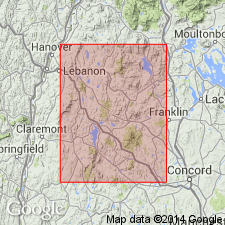
- Usage in publication:
-
- Kinsman Quartz Monzonite*
- Modifications:
-
- Age modified
- Geochronologic dating
- AAPG geologic province:
-
- New England province
Summary:
Rb-Sr whole-rock isochrons for the four main subdivisions of the New Hampshire Plutonic Series yield the following ages: Concord Granite, 359+/-11 m.y. (or 330+/-3 m.y.?); Spaulding Quartz Diorite, 402+/-5 m.y.; Bethlehem Gneiss, 405+/-78 m.y.; Kinsman Quartz Monzonite, 411+/-19 m.y. Concord Granite is at least 40 m.y. younger than other members of the New Hampshire Plutonic Series, making its time of emplacement Late Devonian(?) or Mississippian(?). However, there is enough doubt as to the absolute time scale for the Devonian that the use of Early, Middle, or Late Devonian is not yet warranted.
Source: GNU records (USGS DDS-6; Reston GNULEX).
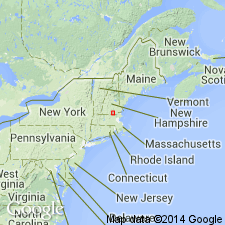
- Usage in publication:
-
- Kinsman Quartz Monzonite*
- Modifications:
-
- Geochronologic dating
- AAPG geologic province:
-
- New England province
Summary:
Kinsman Quartz Monzonite was intruded during the Acadian Orogeny, 400 m.y. ago.
Source: GNU records (USGS DDS-6; Reston GNULEX).
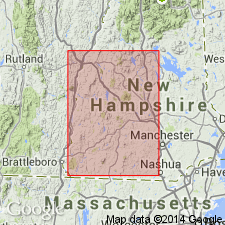
- Usage in publication:
-
- Kinsman suite
- Modifications:
-
- Revised
- AAPG geologic province:
-
- New England province
Summary:
Revised as Kinsman suite within the New Hampshire Plutonic Series (which also includes the Bethlehem, Spaulding, and Concord suites).
Kinsman and Bethlehem range in composition from tonalites to granites. [Abstract refers to unit as Kinsman Series, but this appears to be in error.]
Source: GNU records (USGS DDS-6; Reston GNULEX).
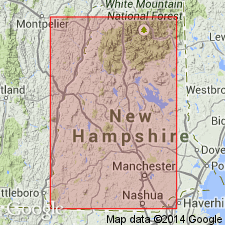
- Usage in publication:
-
- Kinsman Intrusive Suite
- Modifications:
-
- Revised
- AAPG geologic province:
-
- New England province
Summary:
Revised as the Kinsman Intrusive Suite. Includes a variety of rocks classified as quartz diorites, tonalites, granodiorites, and granites. Granodiorite is dominant lithology.
Source: GNU records (USGS DDS-6; Reston GNULEX).
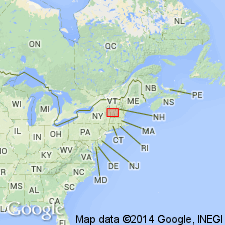
- Usage in publication:
-
- Kinsman Quartz Monzonite*
- Modifications:
-
- Areal extent
- Age modified
- Geochronologic dating
- AAPG geologic province:
-
- New England province
Summary:
Rocks in Merrimack terrane at eastern edge of Glens Falls quad include Bethlehem Gneiss and Kinsman Quartz Monzonite which occupy much of the area. These and other related rock types constitute New Hampshire Plutonic Series of Billings (1956). Radiometric studies indicate 413 Ma age for foliated Kinsman (Barreiro and Aleinikoff, 1985, Geological Society of America Abstracts with Programs, v. 17, no. 1, p. 3). U-Pb zircon dates from Sunapee pluton yield an age of 366 Ma (J.N. Aleinikoff, 1989, oral commun.).
Source: GNU records (USGS DDS-6; Reston GNULEX).
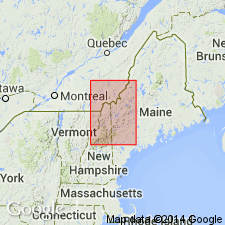
- Usage in publication:
-
- Kinsman Granodiorite*
- Modifications:
-
- Revised
- Age modified
- AAPG geologic province:
-
- New England province
Summary:
Revised as Kinsman Granodiorite to emphasize the granodioritic composition that dominates these rocks. Consists of strongly metamorphosed, foliated, gray, medium- to coarse-grained granodiorite. Locally grades to granite or tonalite. Included in group of rocks dated at between possible Late Silurian and Early Devonian.
Source: GNU records (USGS DDS-6; Reston GNULEX).
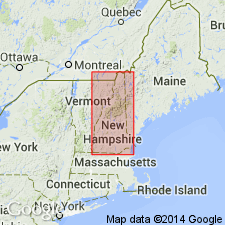
- Usage in publication:
-
- Kinsman Granodiorite*
- Modifications:
-
- Overview
- AAPG geologic province:
-
- New England province
Summary:
Used as Early Devonian Kinsman Granodiorite of New Hampshire Plutonic Suite. Consists of foliated granite, granodiorite, tonalite, and minor quartz diorite; characterized by large potash megacrysts and locally abundant garnet. Report includes geologic map and correlation chart, and 1:500,000-scale map showing plutons and sample localities for age dating.
Source: GNU records (USGS DDS-6; Reston GNULEX).
For more information, please contact Nancy Stamm, Geologic Names Committee Secretary.
Asterisk (*) indicates published by U.S. Geological Survey authors.
"No current usage" (†) implies that a name has been abandoned or has fallen into disuse. Former usage and, if known, replacement name given in parentheses ( ).
Slash (/) indicates name conflicts with nomenclatural guidelines (CSN, 1933; ACSN, 1961, 1970; NACSN, 1983, 2005, 2021). May be explained within brackets ([ ]).

